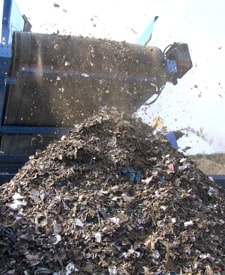As indicated by letsrecycle.com (see letsrecycle.com story) HMRC is looking to produce further guidance which makes it clear exactly when fines are chargeable at the lower rate of landfill tax when sent to landfill. This follows the publication of two pieces of guidance on May 18 and June 1.

But, there now appears to be some delays within HMRC over the guidance although it is still described as being imminent. It is thought that the waste management companies, through the Environmental Services Association, and also the Environment Agency are still in discussion over the evidence process and regulatory matters and this may be a factor in the delay. The new UROC association is also believed to be involved in the discussions over trommel fines as well as other representatives of the sector.
HMRC is thought to be hoping that its document will win the support of all parties and to some extent end the debate over the issue which has been taken up MPs and involved top Revenue officials.
Guidance
The guidance is expected to have a number of points and seek to clarify everything.
For landfill operators, a draft of the latest guidance states that evidence for lower rate taxation will require companies to keep keep sufficient evidence to substantiate applying the lower rate of tax to any particular disposal of waste. To qualify for the lower rate the waste transfer note, which is required to accompany most movements of waste in the UK, must accurately describe the waste so that it can be related to the terms used in the Landfill Tax (Qualifying Material) Order 2011.
HMRC then says that the WTN may cover individual loads or as per the season ticket approach. It emphasises that: If you operate an in-house site and have applied the lower rate to waste which you have disposed of in that site you will need to provide evidence that the waste qualifies for that rate.
And, operators are warned that the requirements relating to the WTN are for tax purposes. They in no way override or affect your obligations in relation to the waste transfer note in environmental protection law including the requirement to define the waste source by reference to the European Waste Catalogue codes.
Explaining the link with lower rate eligibility, HMRC says that the only determining factor as to whether waste is lower rated is whether it is listed in the Landfill Tax (Qualifying Material) Order 2011.
Clarification
For the skip hire firms and waste transfer station operators, HMRC gives clarification in the draft guidance on liability of loads or consignments.
This section is being seen as being particularly useful as it relates to the trommelling process for inert materials under the Order which lies at the heart of the whole debate.
At present and subject to further amendments before formal publication HMRC is saying that a consignment of waste will be taxed at the lower rate of landfill tax when it consists only of materials which are listed in the Schedule to the Landfill Tax (Qualifying Material) Order 2011, providing that the conditions set out in column 3 of the Schedule 1 and any Note to that Group of material in the Order are met. The lower rate also applies where the consignment consists of a number of different qualifying materials, including qualifying materials from different Groups within the Order.
Materials
HMRC says that for example, this means for loads of materials which are commonly referred to as trommel fines, the lower rate will apply only where the materials from which the fines were derived are included within the Order. This can include a mix of qualifying materials from different Groups within the Order.
For loads or consignments of construction soils and soils from demolition of buildings or structures, the lower rated will apply only where all the constituent materials are included within the Order. This is seen as worthy of note as it means that such soils are not always contaminants.
Related Links
In all circumstances, as explained in section 3.3 of LFT13, a consignment of qualifying material can contain an incidental amount of non-qualifying material and still qualify for the lower rate.
And HMRC emphasises that the WTN must accurately record the composition of the waste consignment, setting out specifically which qualifying material(s), or mix of qualifying materials, are contained in the load or consignment. For loads or consignments containing trommel fines or fines the waste transfer documentation must clearly state from which qualifying materials, or mix of qualifying materials, the fines were derived. Further information on evidential requirements is set out below.











Subscribe for free